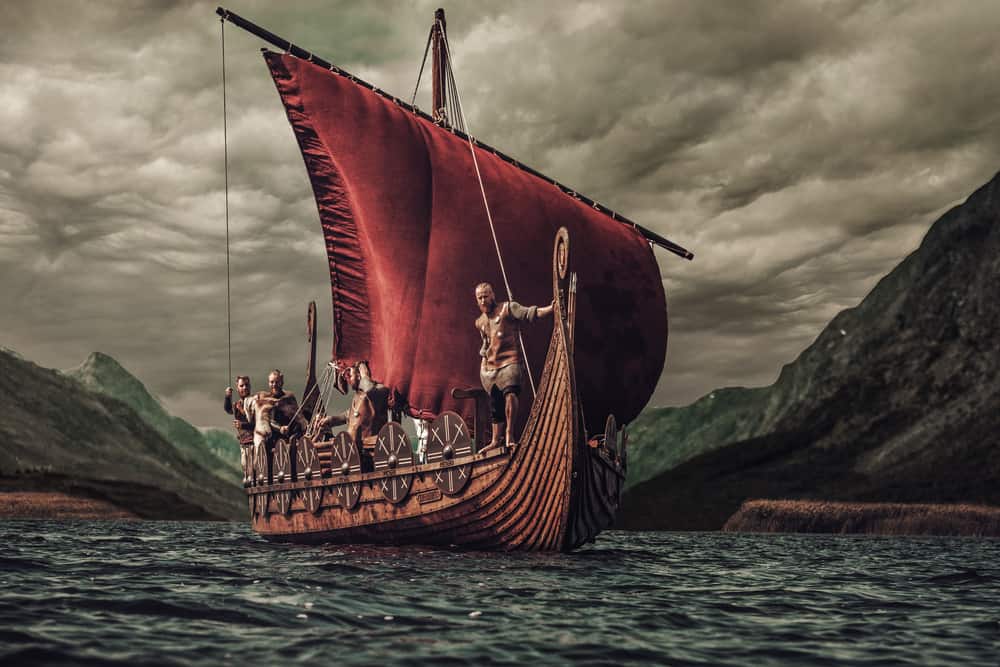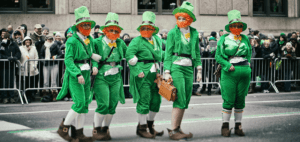Viking History: Insight into the Age of Phantom Travellers

Updated On: April 15, 2024 by ConnollyCove
Thunder, Thor, and brutality. These are the common perceptions of the Vikings. They are people who made a stamp on the world through exploration outside their Scandinavian hometowns and roots.
Let’s skip the blood, guts, thunder, lightning, shouting, and all that stuff you can watch on Game of Thrones or Vikings. Instead, let’s focus on what we know about Viking history and how we know it.
Viking History: Provenance
The Viking Age lasted over 300 years, starting in the mid-700s and ending around 1100 AD. During that time, the Vikings raided countless villages, conquered lands, and explored new areas of the planet. It’s basically common knowledge that their culture has been somewhat misrepresented in the past. No, they didn’t have horns on their war helmets and they didn’t all have massive beards. In all honesty, though, we don’t really know that much about what they were really like.
They weren’t too fond of writing their history. Their societies were spread so far apart that authentic Viking writings of their culture and life are far and few between. Nearly everything of what we know about them is from the accounts of their enemies. Or written centuries after the Viking Age ended.
Vikings were nords. They originated in Scandinavia and were mostly focused on raiding and exploring new lands. Following this livelihood inevitably leads you to weird places. And as such, Vikings raided and explored lands from the Middle East to Africa to North America, and were the first Europeans to do so.
Many believe the Viking Age started with the raid of Lindisfarne, England in 792. Vikings raided a Christian monastery there. Starting off a long line of raids throughout Europe and beyond. Vikings had already raided locations, but this particular event really kick-started the identity the Vikings would build up. Christians already had quite a bit of animosity towards these polytheistic pagans and raiding a monastery didn’t help.
Viking History: No Rest for the Wicked
Viking history effectively does become a series of raids and explores for the next few hundred years. And considering just how widespread these people travelled, it isn’t too surprising in the end that the culture fizzled away. The exact cause for Vikings travelling the globe can’t really be pinpointed. Some argue it was to escape forced conversion by Charlemagne, which would align rather nicely with the advent of the Viking Age.
This would be a large part of Saxon Wars, affecting Germanic peoples. At the same time, some argue that since Vikings gave their first sons all acquired land, younger sons ventured off to gain their own property. Of course, a multitude of reasons could exist: Maybe it was just a byproduct of concentrating. We won’t know for sure, considering the lack of authentic evidence.
The longships were represented as the choice vessel for the Vikings. That’s pretty accurate and conspicuous, albeit a bit less ornate. They were the pinnacle of the ships at the time and contributed to the Vikings’ vast expansion. They crossed the Atlantic hundreds of years before other Europeans.
The combination of oars and sails made the ships remarkably versatile. In open sea or ocean, the sails would be used exclusively and oars would be used near coastal areas or just for boosting speed. One of their best features was the identical front and rear sides. In icy areas where Vikings tend to travel, the ship could go backwards very quickly by rowing in the other direction.
Viking History: Red Sky on the North
Notable achievements of Viking exploration include the discovery of Greenland. Some credit Erik The Red for this, an exile convicted of manslaughter. Whether he discovered the island is doubtful as Nords had likely been to Greenland. But without permanent settlements, it’s impossible to know if they had made it there.
Erik the Red’s son, Leif Erikson, would gain further fame by being credited as the first European to reach North America; landing in modern Newfoundland, he created a settlement called Finland, which would be the first European settlement ever established.
Not all was going well for the Vikings, however. Over time, the Vikings began to lose a decent amount of ground or fall to Christian conversion. Rollo, a Viking chief, was granted the crown in Normandy after promising the French king he would convert to Christianity and keep other Vikings out.
Viking History: Trade and Travel
When the attack above on the Lindisfarne Monastery took place, it is thought that this indicated the beginning of the Viking Age. However, one researcher argues the Viking Age started earlier when the Vikings sailed from Norway to a trading post on Denmark’s coast seventy years before they raided Lindisfarne.
After contacting the Danes, the Vikings didn’t trade with them. Instead, they established a trading route. Evidence to back up the trade route theory is combs made from reindeer antlers found in Denmark. Carbon dating determined that the bones were from an animal that lived around 720 AD.
At the time, reindeer weren’t found in Denmark, they were only found in Norway, and the Vikings were known to use reindeer antlers in their day-to-day lives. These findings also debunked the notion that the Vikings were simply raiders who took what they wanted because they were also skilled traders. Also, these decades of trading gave them training that made them better sea travellers, which led to their explorations and raid numbers.
Viking History: Women Vikings
Female Vikings travelled with the men. For many years, it was believed that when the Vikings came to a new land, they just took what they wanted. This included women. This led to the belief that they would just bring in local women when the Vikings set up a new settlement.
That changed in 2014 when DNA evidence suggested that the Vikings would travel with women from their hometown to places as far-flung as Canada and Russia. There is also evidence to suggest that they came along on journeys to help with colonising the areas. Thanks to the female Vikings, a place like Iceland was colonised. Because the island was inhabited before the Vikings got there. The women’s roles were to help tend the farms while the men were away on raids or dead.
Viking History: Viking Feasts
Besides being notorious raiders and impeccable seafarers, the Vikings were known for their incredible feasts. It is believed that the reason for their feasts was so the host could show off and make himself look powerful because of how many resources he had. These banquets, where they served beer and beef, were held to win favour with local workers and gain political alliances.
The banquets often hosted people from different Viking factions. The dinners were more common than battles between the various factions. Due to this fact, we think most people would rather eat steak and drink some beer rather than battle a group of Vikings, even if you’re a Viking yourself.
This system only worked for a while in Iceland; shortly after the Vikings settled, there was a mini ice age setting, and the winters grew to be nine months long. Due to the cold, the cows needed to be kept inside so they couldn’t graze. This forced the Vikings to feed themselves from their food supply so that they could only keep a practical number of cows. Which meant there was not enough beef for elaborate feasts.
Also, without the barley, alcohol production would have gone down. During the Ice Age, the Vikings in Iceland started more sheep herding because sheep were better suited to the weather. Moreover, the Ice Age spelt the end of the chief of Danes’ positions of power. They stopped being mentioned in the Viking sagas without the stakes in the beer. Yes, that’s right. Their supporters ditched them as soon as they stopped supplying beer and food.
Viking History: Drug Usage
According to old Norse literature, Viking warriors could enter a state called “berserker,” translated literally into “bear shots.” When Vikings went berserk, they would enter a trance-like fury that would help them in battle. One theory on how they entered the state was through eating Amanita muscaria, which are hallucinogenic mushrooms.
The theory, which was first proposed in 1956 by the American Journal of Psychiatry, says that they would have consumed them in a ritual, and when they started fighting, they would have felt the effects of the mushrooms.
Evidence suggests that the mushrooms would have grown in Scandinavia then, and descriptions of the berserker state are consistent with the effects of eating mushrooms. The lesson here is that if someone with Viking blood in them would ask you to do mushrooms with them, just say no.

Viking History: Vikings Filed Their Teeth
After examining 557 Viking skeletons from about 850 to 1050 AD, a Swedish anthropologist discovered that 24 of them had their front teeth filed horizontally so that the teeth were all the same height. This binding seems to indicate that the Vikings used dental modification. However, how they did it and who taught them the procedure is a mystery.
One theory is that the Vikings may have learned this from West Africans. However, the West Africans filed their teeth into points and did not do the same horizontal file on the front teeth found on the Vikings. One would imagine that the Vikings, who already try to look ferocious as part of their battle strategy, would have done it similarly because we doubt there is anything more terrifying than a Viking with pointed teeth.
The only known people who filed their teeth like that were Native Americans living around the Great Lakes area. This has led to speculation that if they share the same dental work, then it’s possible that the Vikings and the Native Americans came into contact with each other during the Vikings’ short-term settlement in Newfoundland, Canada.
Viking History: The Viking Compass
One of the most impressive things about the Vikings was their navigational skills. They explored more of the world from their home in Scandinavia than anyone before them. Two notable feats are reaching modern-day Russia and North America 500 years before Christopher Columbus was born. That made them the first Europeans in North America, and they had permanent settlements there, but how did they do it?
No other civilization came close to traversing the same distance at the time, so what made the Vikings different? Researchers believe that the main reason that they were able to travel such great distances was because of their compass technology.
During that era, people could sail throughout the day because they followed the sun. But at night or when it was cloudy, venturing too far from land was dangerous. With their unique compass, the Vikings could keep going in the right direction even without the sun.
However, only one piece of the mythical compass has been found, which started in the 11th century and was found in Greenland. Only half of what is a wooden disk remains, but researchers believe it was used with a pair of crystals called sunstones and a flat wooden slab.
Viking History: Mead
According to Viking folklore, the Norse god Odin gained strength while drinking mead as a child. Also, if a warrior died in battle when he got to their heaven, Valhalla, he was rewarded with a cup of mead. Mead was an essential drink for the Vikings.
It wasn’t some mythical drink, either. It was an actual substance they drank on earth, and it helped keep the Vikings healthy and helped with infections. The mead was so effective because its main ingredient was honey. Honey has been used for thousands of years as a natural remedy that acts as an anti-bacterial microbe that helps with physical healing.
Another aspect is that mead was made from fermented honey. During fermenting, the lactic acid bacteria, the most medicinal part of honey, multiplied from 100 million grams of honey to 100 billion per gram. This would have made the mead act like an antibiotic, making the Vikings healthier against infection and illness and, ultimately, better warriors.
Viking History: Vikings and the Middle East
The relationship between the Vikings and Christians is pretty well established. Mainly, the Vikings raided the Christians, often attacking their churches and monasteries. Experts do not think that these holy places were targeted because the Vikings were against Christianity. Since the Vikings believed in many gods, accepting the Christian God among their own would not have been a problem.
It is believed that they attacked churches and monasteries because they were often stored with riches and weren’t heavily guarded. Besides interacting with Christians, the Vikings also made it to what is now known as the Middle East. They developed a trade route with Persia a thousand years ago after the two civilizations came across each other while travelling on the Russian steppes.
The Vikings purchased Persian silk, which may have been necessary to them because some silk was found in a burial ship in Norway that was dated to 834 AD. Also found on the burial ship was a statue of a seated Buddha. However, it has never been proven whether the Vikings interacted with Buddhist civilizations.
Viking History: The Vikings Founded Dublin and Other Irish Cities
In several cases, the Vikings set up settlements on uninhabited islands like Greenland, Iceland, Normany, and Newfoundland. They also had settlements and kingdoms near places they raided, such as Great Britain. After the Vikings invaded Ireland in 795 AD, they set up a kingdom called Dubh Linn, which would later become Dublin.
Dubh Linn was a significant trading post for the Vikings and a stronghold in Ireland. Vikings ruled Dublin for 300 years, although they were kicked out briefly. Eventually, the Vikings and the Gaelic people melded with each other, creating an Amalgam culture. Besides Dublin, they established a few different Irish towns like Waterford, Wexford, Wicklow, and Limerick, and these towns became the first trading posts in Ireland.
Viking History: Vikings in Dublin
The number of Viking warrior burials in Dublin is extraordinary in the Viking world, say archaeologists. Many were buried with swords and other Viking paraphernalia. A project cataloguing these burials, which began in 1999, is nearing conclusion. It will result in the publication of Viking Graves and Grave-Goods in Ireland, an 800-page tome.
Viking Norsemen from Scandinavia encountered the basin on their seasonal plundering voyages around the early 9th century. Its location gave them refuge from the northern sea storms and access to the shipbuilding materials found in Ireland’s dense forest.
Clashes notwithstanding, the enterprising Vikings stayed on, integrating with the Irish Celts and establishing a ‘longphort’ (raiding base) around 841. Dubh Linn evolved into the settlement of Dyflin, a significant trading empire with countries as far afield as continental Europe, the Middle East and North Africa. Precious metals, fabrics, weaponry and horses were all traded here, as well as humans — Dyflin had the biggest slave market in Europe following the fall of the Roman Empire.
Although Dublin’s history is still shrouded in uncertainty, it becomes more apparent as Vikings continue to be discovered in the city. In 1961, an extensive Viking settlement was uncovered when construction began on the Dublin City Council headquarters at Wood Quay – the area between the Liffey and Christ Church Cathedral in south Dublin. The cathedral itself was built on the site of a Viking church.
And suppose you are in Dublin in mid-August. In that case, you can celebrate the city’s aggressive Viking history at the Dublin Viking Festival, where a Viking craft village is the central attraction. It’s not as big as St. Patrick’s Day celebrations, but, still worth attending. There are also readings, re-enactments, combat displays, and costumes, including horned helmets.
Viking History: The Vikings Caused the Spread of the House Mouse
One animal found on every continent except Antarctica is the musmusculus domesticus, the house mouse. It is thought that these animals are so widespread, especially in Europe, because they hitch grind on Norweigan Viking ships, which helped spread their population.
The Vikings would have been ideal travelling companions for the mice because the mice would have hidden in the food supply the Vikings needed to conquer new areas. Viking architecture would have also been conducive to mice because they would have burrowed into the walls. Researchers looked at mouse DNA and made a family tree: The House Mice.
They were also able to trace the lineage and found that the mouse population across Europe rose as the Vikings expanded across Europe. It is also unclear if the Vikings knew about the mice. But there were records of them bringing cats with them on their journeys. Then again, the Vikings just might have been cat people.
Viking History: The Norse Viking Settlers in Ancient Greenland
Around the 8th century AD, the Vikings began to spread from the Scandinavian peninsula, raiding, trading and doing what Vikings do. The Vikings travelled to and raided Russia, Byzantines, and, especially, the areas directly adjacent to them, such as the British Isles, Germany, and the Netherlands.
Viking History: Settlement in Scotland
They first settled in small numbers in the Shetland and Orkney Islands off the coast of northern Scotland before arriving in the Faroe Islands in the mentioned century. The Islands were uninhabited then and located about halfway between Scotland and Iceland. The Norsemen raced around 60 years later, making them presumably the first humans in history to step foot on the island.
Viking History: Settlement in Iceland
Iceland became an essential settlement for fishing and whaling for northern sailors upon seeing the bounty of the Atlantic Ocean. A Norwegian sailor named Gunnbjorn Ulfsson was reportedly the first European to discover the island of Greenland.
Settlers from Norway and Iceland accompanied Leif Ericson, who established communities split into eastern, middle, and western settlements. At the height of their population, each place contained around 5000 people. The Norwegian Empire would annex the north Greenlanders, and later, the Danish became a part of the Kalmar Union in the 14th century along with Iceland, Sweden, and Finland.
The settlement soon became isolated from the rest of the Nordic world, with the North Greenlandic language evolving similarly to the Icelandic or Faroese ones, albeit divergent from the Scandinavian languages on the mainland of Europe like Danish, Norwegian, and Swedish.
Viking History: Divide and Conquer
Fascinatingly, Greenland was not the farthest extent of European exploration, with Erikson also reaching the mainland of North America in 1080. Moreover, it’s entirely possible that Norse’s explorations and settlement extended even further south. However, no conclusive evidence has yet been discovered.
Verified chaos began brewing in the late 14th and 15th centuries when global temperatures dropped drastically. The settlements in Greenland found that their crop produced less and less yield every year. And virtually nothing to hunt on land besides the occasional polar bear or caribou. The Norsemen turned to the seas, with studies showing that the last diets of the settlers consisted almost entirely of fish and whale meat.
The settlers gradually began to starve and freeze to death, seeing how they were not afforded the luxury of living on a lush volcanic island such as Iceland, and the population dwindled in a matter of decades, with settlers starting to panic. Records show that in some villages, all of the elderly were slaughtered and dumped during the winter to preserve food. I know, pretty dark stuff.
Viking History: Tough Times in Greenland
Freezing temperatures cut off Greenland from the rest of the Norse colonies and trading contact was halted soon after that. Ironically, the last of Norse and Greenland had perished only decades before Columbus’s first voyage. The age of exploration and colonization commenced with the entirety of the North and South American continents being entirely colonised by the Europeans in only a couple of centuries.
Before the Norse died out, though, it is known that they did establish contact with the Inuit people who had started settling Greenland by the 13th century, replacing the Dorset peoples that had previously inhabited the island, and the Inuits migrated south, encountering the Norse.
Viking History: The Viking Slave Trade
Vikings have been popularised in mythology as murderous plunderers. A far less common association but equally appropriate for the ruthless Vikings is the Viking slave trader.
As one Arabic writer noted, trading was an integral part of the Viking economy. The Viking ruse had no cultivated fields, so Vikings would not only enslave the local population of the settlements they raided in France, Britain, and Ireland but also demanded slaves as tribute from the Eastern Slavic communities in Russia and Finnish farming communities.
Viking History: The Harshness of Enslavement
So prolific was the enslavement of the Slavic people that English speakers derived the word “slave” from “Slavic.” Many of the enslaved were destined for rich vibrant markets in the Islamic World, such as those in Baghdad. The Viking ruse was used extensively on Russian waterways to transport not only their slaves but also other Baltic goods.
Contemporaries noted that the Vikings treated their slaves well and dressed them appropriately. But not out of any humanitarian concerns. Rather, they wanted to make sure that their merchandise wasn’t damaged and was presentable. To extract maximum silver from their slaves. Female slaves were also expected to fornicate with their Viking slave masters.
It should be noted that during this period, it wasn’t just Muslims and Vikings who were engaging in slave trading. Much of Europe was involved in slave trading. The Venetians were especially adept at buying and selling slaves.
Viking History: What If the Vikings Stayed in America?
If there was one thing a Viking was, first and foremost, he was an avid sailor. Their fantastically crafted ships allowed the Scandinavians to explore new lands peacefully or not. The Viking Age, yes, was an age of pillaging and bloodshed, but it was also an age of colonisation and exploration.
As mentioned, the Vikings could colonise Newfoundland in Canada (known as Vinland then). The colony of Newfoundland failed in the span of a few years. There was just too much going against it to be successful. However, the idea of Scandinavians living in the New World 500 years before Columbus’s discovery is far too interesting, and we should not discuss it. So let’s imagine what if the Vikings stayed in America in an alternate timeline? That failed colony of Newfoundland somehow stayed alive, just like Iceland. Before I get into that question, I want to answer this one: Why did Newfoundland fail in the first place?
Viking History: Failure of Newfoundland
First are the natives, or “Scraeling” as the Vikings called them. The Vikings and natives didn’t go along. The very first confrontation included the Vikings killing two natives while the natives then chased them off.
The second was the population of Scandinavia itself. The Vikings were far outnumbered. The Scandinavian population was minuscule. A vast Viking population in Canada? Not likely.
The third was navigation and technology. Even for the Vikings, the journey was arduous, so don’t imagine the regular trips that future societies could easily make to the New World. Vikings were best on the shore and not really in the open ocean.
My point is that I know that surviving Newfoundland is practically impossible. This is more or less theoretical, taking all these factors into account.
Viking History: The Vikings and the Natives
So, let’s move on to the scenario: if you imagine North America in this alternate timeline having some hybrid culture between Vikings and natives, I’m sorry to crush your thoughts. The Vikings never wanted to intermingle with the natives, and even if somehow they did, there were very few Vikings who could create some hybrid culture. The colony would simply become less Scandinavian over time and disappear.
What I qualify as colonisation and success is Newfoundland’s survival to create a lasting Scandinavian presence in Canada. Be enough of a success that word comes out; more Vikings show up to sustain the colony in North America.
There are, of course, multiple possibilities for that scenario. But, in general, the Americas would be something that Europe would have known about for centuries before actually reaching it. Of course, we’ll never honestly know what would happen if Vikings colonised America, but it’s fun to theorise.
Viking History: The End of the Viking Age
Many people put the end of the Vikings in the 11th century. At this time, several things were happening.
Firstly, Scandinavia was becoming more and more politically centralised. That shaped the beginning of modern Scandinavian nations, as we know them.
A leading source of Viking opportunity to go raiding was how their class structure was established. It was a greater emphasis on democracy and less of a focus on having single, unquestionable leaders. There is a story, in fact, of Vikings in France being asked to identify their leader, to which they replied: “We are all leaders here.”
Later, that all changed; the wealthy elite moved higher to the top governments, became more centralised, and encompassed more territory. The then-Viking-homelands began to resemble other European nations.
Viking History: Changes of the Vikings
Secondly, the Norse were becoming Christians. Remember that Leif Erikson had been sent to spread Christianity in Viking-occupied territories? Yes, well, the urge to resist Christianity was diminishing, and almost all Scandinavian nations turned from pagans into Christians.
Furthermore, Viking explorations sort of slowed down at that time, too. The Vikings indeed proclaimed most grounds on the north-west side of the world. But they didn’t stay there for too long. Around 1000 AD, they got kicked out of North America and after that North America was just a mysterious land and the Vikings stopped sending people there.
The colony in Greenland would also eventually fail. Over hundreds of years, Greenland lost contact with the rest of Europe. The climate changed, growing colder and harsh.
Various factors likely contributed to the mysterious disappearance of the Norse of Greenland. By the 15th century, the colonies were entirely abandoned. Europe itself was changing in ways that also made Viking raids less feasible. Nations like England and France started maintaining their standing and professional armies. The kings of these nations were tired of the Vikings and built defences around vulnerable targets.
Viking History: End of an Era
The Viking Age was coming to an end. The influence of the Norsemen was fading. Slowly, the Viking culture and religion began to fade out of existence as they lost land, and many converted to Christianity. This conformity, more or less, effectively ended the Viking Age. However, many regard one final event as the ultimate conclusion.
Earl Totsig Godwinson was exiled from England after a rebellion following a rather poor attempt at ruling Northumbria. His resentment led him to contact the king of Norway, Herald Hardrada. He convinced the King to march into England. So, in 1066, King Hardrada and Godwinson went to war with the king of England.
Viking History: The End of the Viking Culture
They both failed and got killed. An already weakened Viking culture had finally reached its end. Around this time, the beliefs and culture of the Vikings and Nords slowly began disappearing, with Christianity taking prominence. This was a slow process, though. It took nearly two centuries after the fall of the Vikings for Christianity to be universal throughout Scandinavia.
I wish more could be said about the Vikings, but in all honesty, moving too far outside battles and raids leads to a profound amount of uncertainty. Those the Vikings raided documented Vikings far more than they did themselves, along with Christians who had a bit of a bias considering the Vikings’ paganism.
The famous Norse sagas detailing their culture in history were created after the Viking Age had ended. Complicating the legitimacy of some stories.
Viking History: In a Nutshell
The Viking history is a strange one. The same can be said for their legacy. Minimal authentic history was preserved from such a widespread culture. Norse culture had somewhat influenced Western civilization. For those unaware, Thursday is named after Thor’s Day. And even though the Viking Age ended, it’s still pretty hard to forget about those fearsome and ruthless fighters.
Which fact did you find interesting about the Vikings through this article? Let us know in the comments below!






